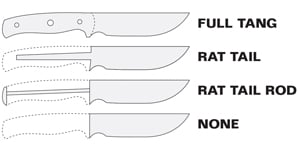Knife Buying Guide
Whether it is a tactical or everyday carry knife, having all of the necessary information is absolutely essential before you make a purchase. From the shape of the blade to the type of steel it is made of, the knife's anatomy is complex and it is extremely important to take into consideration all aspects of a knife before you decide which one is right for you.
Different knives have different purposes, so be sure to take into account the 9 key parts of a knife's composition.

1. Blade Shape:
The blade shape is important because it determines what the knife is optimized for. There are several different shapes, the most common being:
Clip Point

One of the most popular shapes, the Clip Point blade is easily identifiable as it looks like the end of the knife has been 'clipped' off. It is easily maneuvered and comes to a very sharp point at the end. Perfect for making quicker and more controlled cuts.
Drop Point

Popular as hunting knives, the drop point blade shape also features a lower point that allows for more control. The difference between a drop and clip point, however, is the added strength of the tip due to the entire blade being curved downward, not clipped off at the end.
Tanto

The Tanto shape is specifically made for cutting through tough materials by having an extremely thick blade. However, it was specifically crafted for this one purpose, therefore it would not be used as an everyday carry knife as it lacks the tactical qualities of one.
Sheepsfoot

The Sheepsfoot looks similar to a cleaver and is generally intended for chopping/ making clean slices. The spine of the blade is smooth to allow for more control and precision since you may use your fingers to hold it.
Dagger/Needle Point

A Dagger/Needle-Point blade is ideal for stabbing into softer objects. The two sides taper into a sharp point able to cut on both sides as well as being easily hidden, however, the drawback is that it may break if used on harder materials.
Spear Point

Similar to the Dagger shape, the Spear point blade also features two edges for cutting, however, the Spear point has a small belly to allow for slicing. The point of the blade is also much stronger. This blade style is usually found on throwing knives.
Trailing Point

With a blade curved upward, this blade shape features a huge belly that is ideal for hunting and fishing since this knife is specifically made for slicing. However, the tip is fairly weak despite having one of the sharpest points of any blade style.
Gut Hook

The Gut Hook style blade looks similar to a drop point blade only it features a hooked end perfect for gutting. The hook is sharp enough to sever the skin, but small enough not to tear into muscle. It is great for field dressing.
Naturally, each blade shape comes with different advantages and disadvantages. So it is important to research exactly what blade shape is best for you.
2. Edge Type
There are three main edge types:
Straight edge

Straight edges are ideal for making clean and swift slices and are easily sharpened.
Fully Serrated

Fully serrated edges do not cut as smoothly but are great for severing tougher materials such as rope. Though it stays sharper for longer, it is harder to sharpen.
Partially Serrated

Partially Serrated knives are like the best of both worlds. It features a half straight, half serrated knife blade that can be easily adapted to make the cut you need.
3. Handle
It is important to pick a knife handle material that you trust to hold up when you need it. There are several different materials that can be used, so you must take into account the type of grip you need, the environment you will use your knife in, and just how much outdoor/use your knife will receive as well as any other factors you think will influence how well your knife handle will hold up.
4. Point
The placement and sharpness of the point of your knife is a crucial factor to consider. The angle and thinness help determine the amount of control you have as well as the strength and what materials you can cut.
5. Tip
This is different from the point of the blade. Important to consider if you need to make finer cuts.
6. Guard/Bolster
This connects the knife blade to the handle. It helps protect your hand, adds weight to the knife, and helps with balance and control.
7. Tang
Though lesser known, the tang is a very important feature of a knife. It is the part of the blade that is covered by the handle of the knife. There are a few different types of tangs, and it is important that you know which kind your knife has as they offer different types of supports/weights.

8. Butt/Pommel
This is the bottom of the handle at the end of the knife. It can be plain or embellished with tactical features such as a glass breaker or fitted with other hard materials to be used in emergency situations.
9. Spine
The spine is the opposite side of the knife edge. It can either be smooth or have some type of edge on it. Smoother spines can be used for support since you may put your fingers on it, whereas double edged knives have more tactical uses.





Login and Registration Form